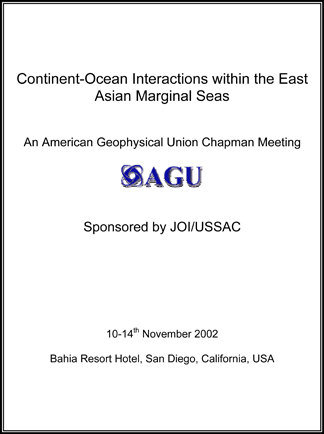AGU Chapman Conference: Continent-Ocean Interactions within the East Asian Marginal Seas
November 10-14, 2002 – San Diego, California
Convener: Peter Clift

Executive Summary
Understanding interactions between the continents and oceans represents a frontier area for the ocean and earth sciences in the 21st century. At an AGU Chapman meeting, held in November 2002 and sponsored by JOI/USSSP, the nature of these interactions in east Asia were discussed with presentations examining climate-tectonic interactions, continental-oceanic climate variability, material flux from the great rivers of Asia into the global ocean, as well as how the tectonic development of Asia following India-Asia collision has influenced the oceanic tectonics of the western Pacific. Apart from scientific interest, understanding the climatic systems of East Asia (monsoon and Western Pacific Warm Pool) is of high societal relevance to the countries of that region and worldwide, given the influence these systems appear to have on the global climate.
The sedimentary sequences preserved in the marginal seas that surround the Asian continent were identified as detailed recorders of how continent-ocean interactions have evolved through time in this region, making them appropriate targets for future marine geological and geophysical surveying. Drilling of the Asian marginal seas during the tenure of the Ocean Drilling Program has already lead to important developments in our understanding of how and when these basins formed, and how the paleoceanography of these regions has evolved in response. Significant advances have been made in showing that basin opening was roughly synchronous in the Sea of Japan and South China Sea, suggesting a linked origin, possibly related to continental extrusion tectonics. In climate studies major changes in continental erosion are now recognized starting at 16 Ma, possibly caused by early Miocene monsoonal strengthening, while on shorter orbital and millennial time-scales variations in the oceanic carbon reservoir, which is driven by monsoonal strength, were seen to be modulating high latitude glacial cycles. The paleontological record from the South China Sea also showed that the present West Pacific Warm Pool was formed probably 3–4 Ma, an important part of the El Nino cycle that affects much of the circum-Pacific climate.
The great thicknesses of sediment on many of the passive margins and the common development of hydrocarbons has previously hampered research in the region. However, IODP marks an important change in its ability to drill these previously difficult targets. The meeting made a series of recommendations for possible future drilling goals, including investigation of (1) the rift tectonics in the Asian marginal seas, especially the South China Sea, as a contrast to both the volcanic and non-volcanic margins of the Atlantic, (2) the arc-continent collision zone of Taiwan and the formation of the Okinawa Trough with significance for the origin of the continental crust and the formation of active continental margins, (3) the delta and deep-sea fan complexes associated with the great rivers of East Asia, as records of Tibetan topographic uplift, climate change and the erosional response, (4) the carbonate reefs of the South China Sea, as recorders of high resolution climate and sea-level change, and (5) the Sunda Shelf to establish the longterm history of climate and sea-level changes and its relationship to atmospheric processes where the greatest ocean-atmosphere transfer of heat and moisture occurs. Success in these areas will require long-term commitment and planning by scientists from many sub-disciplines working together with colleagues through the East Asian region.
Workshop Report (pdf)
Converners
Peter Clift, Woods Hole Oceanographic Institution
Pinxian Wang, Tongji University






